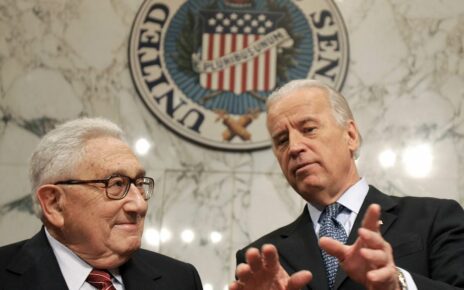Sweeping climate and health care legislation unveiled by Democrats last week would lead to significant cuts in energy costs for American households, according to a new analysis.
A report by non-profit group Rewiring America found that the tax incentives included as part of the $369 billion dedicated to climate initiatives in the Inflation Reduction Act would save the average household $1,800 per year on energy bills.
“It is a market-tilting level of investment,” Ari Matusiak, the group’s co-founder and CEO who was involved with the crafting of the bill, told Yahoo Finance. “The beneficiaries of [this measure] in the long term are going to be all of us on the planet. In the short term, it’s going to be Americans at their kitchen tables realizing savings on a month-to-month basis.”
The new measure sets out to accelerate the transition to renewable energy and dramatically reduce the country’s greenhouse gas emissions through a slew of tax incentives aimed at reducing the cost of electrification.
While those cost savings are dolled out among more than 100 different programs, Matusiak said the biggest reductions are likely to come from rebate and credit programs that cushion the cost difference between electric appliances and cars, and those that rely on fossil fuels.
Here are some of the biggest cost savings.
Electrifying households
A program dubbed the High Efficiency Electric Home Rebate Act (HEERA) sets aside $4.5 billion in direct rebates for low- and moderate-income households that install new, efficient electric appliances.
Under the proposed rebate framework, a low-income household would receive a rebate of up to $8,000 for a new heat pump, $840 for an electric stove or electric dryer, and $2,500 for updated electrical wiring, among other rebates. Matusiak said those incentives will enable 1 million households to go electric.
“The challenge is that these machines are new and they are not ubiquitous in the market yet, so they have not yet achieved industrial scale, which means that their prices off the showroom floor are higher than the fossil fuel machines that they will be replacing,” he said. “So the investments in the Inflation Reduction Act are directly going at bridging the delta between the cost of an off-the-showroom fossil fuel machine versus a clean electric machine.”
Credits for EV purchases
The climate legislation also sets aside new money for a $7500 federal vehicle tax credit, expected to give major car makers like Tesla (TSLA) and GM (GM) an added lift, along with drivers.
While the credit for new electric vehicles is seen as an extension of an existing program, the clean vehicle credit program comes with additional conditions, including a requirement that eligible cars be built with materials sourced and processed in a country that the U.S. has a free trade agreement with. It also requires the battery used to include a large number of components manufactured in North America.
In addition, the legislation sets aside a $4,000 tax credit for used cars for the first time. The income threshold would be capped at $300,000 in adjusted gross income for joint filers or $150,000 for individual filers. Credits would be capped at an income level of $75,000 and $150,000 for used cars.
The incentives come as drivers increasingly look toward electric alternatives in the face of historically high gas prices. While the national average for a gallon of gasoline fell to $4.19 on Tuesday, according to AAA, the cost to drive an EV averages out to $1.06 a gallon, Matusiak said.
“41% of the inflation that consumers are experiencing are because their energy bills directly are going up at the pump and at their kitchen table,” he said. “And electrifying the machines that we use in our day-to-day lives structures that inflation out of our lives forever. So it is not just about whether you’re going to get to that $1,800 number this year, but it’s whether you are going to reduce the amount of money that you spend on energy year over year for the next 20 years.”
Matusiak also pointed to additional credits that allow homeowners to deduct up to 30% of the cost of energy efficient upgrades to their homes, as all part of the $1,800 cost savings estimated.
Impact to inflation
Economists remain divided on the impact of the legislation on inflation.
Former Treasury Secretary Larry Summers, who has been critical of the impact the Biden administration’s pandemic stimulus has had on inflation, has publicly supported the bill, saying it would fight inflation by reducing the budget deficit significantly over time.
“You’re raising more than $2.00 in revenue for every dollar that you spend,” he told CNN.
Meanwhile, a study by the Penn Wharton Budget Model estimated the legislation would “very slightly increase inflation” until 2024 before pulling back. The report released Friday “indicated low confidence that the legislation will have any impact on inflation.”
The Committee for a Responsible Federal Budget (CRFB) said the new measure amounted to the largest deficit reduction bill since 2011, calling it “welcome improvement” with inflation at a 40-year high.
“In the near term, people are going to see their costs go down because lower energy costs and because health premiums aren’t going to rise,” Marc Goldwein, CRFB’s senior director of policy, said on Yahoo Finance Live (video above). “That’s not actually anti-inflationary in itself. But it can be anti-inflationary to the extent that those things are paid for, so they’re not putting more money into the economy, and to the extent that they help with expectation.”
Akiko Fujita is an anchor and reporter for Yahoo Finance. Follow her on Twitter @AkikoFujita
Click here for the latest economic news and economic indicators to help you in your investing decisions
Read the latest financial and business news from Yahoo Finance
Download the Yahoo Finance app for Apple or Android
Follow Yahoo Finance on Twitter, Facebook, Instagram, Flipboard, LinkedIn, and YouTube
Source: Read Full Article




